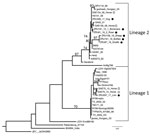

- #Clc genomics workbench 8.5 exclude host using primers full#
- #Clc genomics workbench 8.5 exclude host using primers software#
Using a whole genome approach and a novel algorithm, termed BioVelocity, we identified new signatures that are unique to each of EBOV, Sudan virus (SUDV), and Reston virus (RESTV). These results revealed differences in performance between assays but were comparable between the old and new EBOV templates. We further empirically evaluated many EBOV assays, under real time PCR conditions using EBOV Kikwit (1995) and Makona (2014) RNA templates. We evaluated signature erosion in ebolavirus molecular assays using an in silico approach and found frequent potential false-negative and false-positive results. majus should therefore be monitored regularly for the virus and managed accordingly in China.Ĭausal Agent Crop Type Epidemiology Ornamentals Subject Areas Viruses and viroids disease development and spread herbaceous/flowering plants.Genome sequence analyses of the 2014 Ebola Virus (EBOV) isolates revealed a potential problem with the diagnostic assays currently in use i.e., drifting genomic profiles of the virus may affect the sensitivity or even produce false-negative results. majus plants not only lose their aesthetic and economic values (Figure S1, f), but also may act as reservoirs for the spread of TSWV to other important crops. majus in China, and the second in the world since the first report in the USA (Ie, 1964). To the best of our knowledge, this is the first report of the TSWV infection in T. RT-PCR assay with primer pair S-1F/1R on all samples led to positive detection of TSWV only in the symptomatic samples (Figure S1, g), indicating that the virus was likely responsible for the disease symptoms observed in T. No reliable recombination events were detected in the RNA segments of LN-HJL by the RDP4 program (Martin et al., 2015). These results, together with phylogenetic analysis, suggest that the isolate (designated as isolate LN-HJL) was likely resulted from genome reassortment between other isolates. They shared a sequence identity of >99% with the "LL-N.05" (segment L, KP008128) and "SPAIN-1" (segment S, AY744479) isolates from tomatoes in Spain and the "Beijing" isolate (segment M, MH717046) from chrysanthemum in China. The RNA segments were determined to be 8,914 nt (L, accession no.
#Clc genomics workbench 8.5 exclude host using primers software#
The resulting sequences were assembled and analyzed using the DNAMAN version 8.0 (LynnonBiosoft, Quebec, Canada) and DNAStar version 6.0 software (DNAStar Inc, Madison, WI, USA) (Table S1). These amplicons were then cloned into the pMD18T vector (TaKaRa, Dalian, China) and Sanger sequenced. Five, three, and two amplicons were obtained for the TSWV RNA segments L, M and S, respectively, from the same RNA sample used in the RNA-Seq process.
#Clc genomics workbench 8.5 exclude host using primers full#
Ten primer pairs were designed based on the TSWV contigs to obtain the full genome sequence of the virus (Table S1). No sequences of other viruses, viroids included, were detected. Among the contigs, three sized at 8801, 46 bp were found to share a sequence identity of 98.74-99.35% with the RNA segments (L, M and S) of TSWV. Clean reads were assembled into 88,091 contigs ranging in length from 200 to 19,695 bp using Velvet (Zerbino and Birney 2008). A total of 109,279,540 quality-filtered reads were obtained using the CLC Genomics Workbench 9.5 software (Qiagen, Valencia, CA, USA). The library was subjected to RNA-Seq using a BGISEQ platform (Shenzhen Huada Gene Science and Technology Service Co., Ltd., Shenzhen, China). The RNA from one representative symptomatic sample (Figure S1, d) was used to construct an rRNA-depleted library using the Ribo-Zero™ rRNA Removal Kit (Plant Leaf) (Illumina, CA, USA). To reveal the possible viral agent associated with the disease, leaf tissue was collected from 9 symptomatic and 2 asymptomatic plants, followed by total RNA extraction from each of the samples using RNASimple Total RNA Kit (Tiangen, Beijing, China). majus plants in Beiling Park in Shenyang City, Liaoning, China.

In June 2019, a serious leaf mosaic disease (Figure S1) was observed in ~77% of T. It is also known for its medical, edible and cosmetic values (Jakubczyk et al., 2018). Nasturtium (Tropaeolum majus L.), a common flowering plant species native to Peru, is generally cultivated as a garden and greenhouse ornamental plant in China. Major economic losses caused by TSWV have been recorded in various crops such as tomato, pepper and lettuce (Pappu et al., 2009 Adams et al., 2017). Tomato spotted wilt virus (TSWV, Genus Orthotospovirus, Family Tospoviridae) is a thrips-transmitted negative-stranded RNA virus with a large host range.


 0 kommentar(er)
0 kommentar(er)
